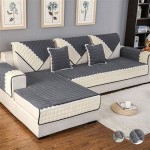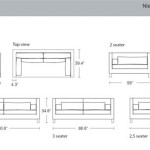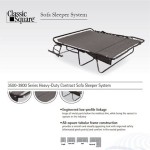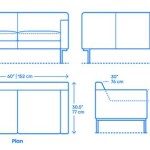```html
The Enduring Appeal of the Vintage 2-Seat Sofa
The vintage 2-seat sofa, often referred to as a loveseat, holds a significant place in the history of interior design. Its compact size, coupled with its ability to offer comfortable seating for two, has made it a popular choice for homes of all sizes for decades. Exploring the characteristics, styles, and care of these sofas provides valuable insight into their enduring appeal.
The term "vintage" generally applies to items produced at least 20 to 30 years ago, implying a level of craftsmanship and design aesthetic distinct from contemporary furniture. Vintage pieces often showcase materials and construction techniques less common in modern manufacturing, contributing to their unique charm and often higher quality. When considering a vintage 2-seat sofa, understanding its origins and the historical context in which it was created is crucial for appreciating its value and ensuring its proper care.
Beyond its functional purpose, the vintage 2-seat sofa contributes significantly to the overall aesthetic and atmosphere of a room. Its style can range from the mid-century modern simplicity to the opulent detailing of Victorian-era designs. Choosing a vintage piece allows individuals to express personal style and create a space that is both comfortable and visually appealing. The sofa serves as a focal point, influencing the selection of other furniture and décor elements within the room.
Key Characteristics of Vintage 2-Seat Sofas
Several key characteristics distinguish vintage 2-seat sofas from their contemporary counterparts. These characteristics include the materials used in construction, the design aesthetics prevalent during the sofa's era of creation, and the overall craftsmanship evident in its detailing.
Materials: Vintage sofas often feature solid wood frames, particularly hardwoods like oak, walnut, or mahogany. These woods provide exceptional durability and contribute to the sofa's longevity. Upholstery materials vary widely depending on the era, ranging from luxurious velvet and brocade fabrics to more practical wool and cotton blends. The quality of these materials often surpasses that found in mass-produced modern furniture. The presence of natural materials, such as horsehair stuffing or down-filled cushions, is also characteristic of older pieces. These features not only contribute to the comfort of the sofa but also add to its historical value.
Design Aesthetics: The design aesthetics of vintage 2-seat sofas reflect the prevailing styles of their respective eras. For example, mid-century modern sofas are characterized by clean lines, minimalist silhouettes, and the use of materials like teak and formica. Victorian-era sofas, on the other hand, are often more ornate, featuring elaborate carvings, button-tufted upholstery, and decorative fringe. Art Deco sofas showcase geometric patterns, bold colors, and luxurious materials such as velvet and silk. Understanding the design aesthetics associated with different periods allows individuals to identify the origin and style of a vintage sofa and to appreciate its historical significance.
Craftsmanship: The craftsmanship evident in vintage 2-seat sofas is often superior to that found in contemporary furniture. Skilled artisans meticulously constructed these sofas, paying close attention to every detail. Hand-carved details, intricate stitching, and durable joinery techniques are common features. The quality of the construction ensures that the sofa can withstand the test of time, continuing to provide comfortable seating for generations. Examining the craftsmanship of a vintage sofa can provide valuable insights into its quality and value.
Popular Styles of Vintage 2-Seat Sofas
The world of vintage 2-seat sofas encompasses a wide range of styles, each reflecting the aesthetic preferences of its time. Familiarizing oneself with these styles is crucial for selecting a sofa that complements a particular interior design scheme.
Mid-Century Modern: Mid-century modern sofas, popular from the 1940s to the 1960s, are defined by their clean lines, simplicity, and functionality. These sofas often feature tapered legs, minimalist silhouettes, and a focus on natural materials. Common upholstery fabrics include wool, tweed, and vinyl. Colors typically range from muted earth tones to bold accent colors. Mid-century modern sofas are a popular choice for those seeking a timeless and understated look.
Victorian: Victorian sofas, prevalent during the reign of Queen Victoria (1837-1901), are characterized by their opulence and ornate detailing. These sofas often feature deep button-tufting, rolled arms, and elaborate carvings. Luxurious fabrics such as velvet, brocade, and damask are commonly used for upholstery. Colors tend to be rich and vibrant, including jewel tones like ruby red, emerald green, and sapphire blue. Victorian sofas add a touch of elegance and grandeur to any space.
Art Deco: Art Deco sofas, popular in the 1920s and 1930s, showcase geometric patterns, bold colors, and luxurious materials. These sofas often feature streamlined silhouettes, chrome accents, and stylized motifs. Common upholstery fabrics include velvet, silk, and leather. Colors range from rich jewel tones to contrasting black and white combinations. Art Deco sofas evoke a sense of glamour and sophistication.
Chesterfield: While often associated with larger sofas, Chesterfield designs are also found in 2-seat versions. Known for their deep button-tufting, rolled arms, and typically leather upholstery, Chesterfield sofas offer a classic and distinguished look. The button-tufting creates a diamond pattern across the back and arms, adding to the sofa's visual appeal. Chesterfield sofas are often associated with traditional and formal settings.
Caring for a Vintage 2-Seat Sofa
Proper care is essential for preserving the beauty and longevity of a vintage 2-seat sofa. Regular cleaning, appropriate upholstery care, and preventive measures can help maintain its condition and prevent damage.
Regular Cleaning: Regular cleaning is crucial for preventing the build-up of dust, dirt, and allergens on a vintage sofa. Vacuuming the sofa weekly using an upholstery attachment helps remove loose particles. Spot cleaning spills and stains immediately prevents them from setting into the fabric. Avoid using harsh chemicals or abrasive cleaners, as these can damage the upholstery. Instead, opt for gentle detergents or specialized upholstery cleaners recommended for vintage fabrics. Testing any cleaning product on a small, inconspicuous area first is always advisable.
Upholstery Care: The specific care requirements for a vintage sofa's upholstery depend on the type of fabric. Velvet upholstery requires regular brushing to maintain its pile and prevent matting. Leather upholstery should be conditioned periodically to prevent cracking and drying. Delicate fabrics like silk require professional cleaning. Consult with a professional upholstery cleaner for advice on the best methods for cleaning and preserving the specific type of fabric on your vintage sofa.
Preventive Measures: Taking preventive measures can help protect a vintage sofa from damage. Avoid placing the sofa in direct sunlight, as this can cause the upholstery to fade over time. Use furniture covers or throws to protect the sofa from spills and stains. Avoid sitting on the arms or edges of the sofa, as this can put excessive stress on the frame. Regularly inspect the sofa for signs of wear and tear, such as loose buttons or frayed seams, and address these issues promptly. By taking these preventive measures, individuals can help ensure that their vintage 2-seat sofa remains in excellent condition for years to come.
Furthermore, when moving a vintage 2-seat sofa, proper lifting and carrying techniques are crucial to avoid damage to the frame and upholstery. It is advisable to wrap the sofa in protective padding to prevent scratches and dings during transport. For particularly delicate or valuable sofas, consider hiring professional movers experienced in handling antique furniture.
By understanding the characteristics, styles, and care requirements of vintage 2-seat sofas, individuals can make informed decisions when selecting and maintaining these timeless pieces of furniture. The enduring appeal of the vintage 2-seat sofa lies not only in its aesthetic charm but also in its ability to connect us to the past and provide comfortable seating for generations to come. The careful consideration and preservation of these pieces ensures their continued presence in homes and collections for years to come.
```
Vintage 2 Seater Sofa 1970s For At Pamono

Danish Vintage Model 55 Velvet Mid Century 50s 2 Seat Lounge Sofa Settee Saffron

Loveseat Sofa Vintage 55 9 Upholstered Two Seater With 2 Dumpling Shaped Throw Pillows Arm Rest And Solid Wood Legs Tulip Pattern Mid Century

Danish Mid Century Vintage Inspired 60s 70s Model 60 2 Seater Club Sofa Settee In Yellow Ochre Multi Weave Fabric

Vintage Brown Leather Chesterfield Two Seat Sofa Loveseat England Circa 1960 80

Vintage Ds 44 Buffalo Leather Lounge 2 Seater Sofa By De Sede Switzerland 1970s

Hepburn Vintage Velvet 2 Seat Sofa From Old Boot Sofas

Vintage Cigar Leather Tufted 2 Seater Sofa

2 Seater Antique Tan Brown Leather Chesterfield Sofa British Handmade Traditional Design

Vintage 2 Seat Sofa Big Comfy Couch Bed Furniture Loveseat For Living Room








